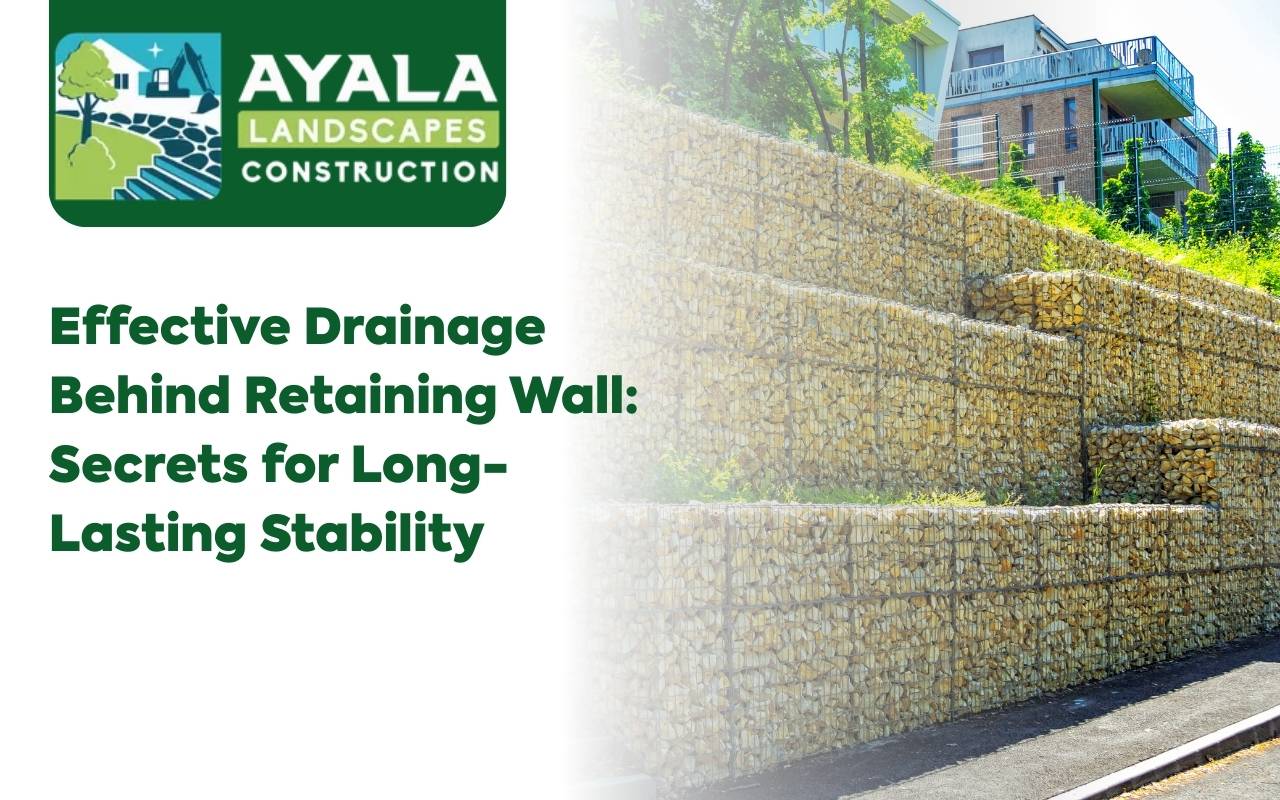
Every homeowner knows retaining walls manage soil, prevent erosion, and beautify landscapes. However, without proper drainage behind retaining wall structures, stability is compromised. Poor drainage increases risks, causes structural failure, and invites costly repairs. Fortunately, practical solutions exist. Understanding how water impacts walls allows you to create strong, durable systems. With smart design, correct materials, and routine maintenance, you ensure safety and peace of mind. This guide reveals best practices for reliable performance year after year.
Importance of Proper Drainage Behind Retaining Walls
Hydrostatic pressure forms when water builds behind walls. This invisible force stresses foundations and weakens stability. Installing effective drainage behind retaining wall structures relieves pressure and redirects water safely away. Proper drainage reduces risks of cracks, tilting, or collapse. It also prevents stains and moss growth, preserving aesthetic appeal. Reliable systems protect nearby gardens, walkways, and hardscapes from flooding. Investing in drainage saves time and money, while also ensuring long-term security for your property.
Common Issues Caused by Poor Drainage
- Bulging or leaning walls due to saturated soils
- Foundation erosion caused by uncontrolled water flow
- Cracks forming from trapped moisture pressure
- Root intrusion destabilizing soil behind the wall
- Unsightly efflorescence from mineral deposits
Ignoring warning signs can lead to dangerous outcomes. Address issues quickly with proven solutions. Installing drainage behind retaining wall areas early prevents expensive reconstruction. Thoughtful prevention maintains both beauty and structural integrity.
Best Practices for Drainage System Design
Effective design starts with soil and slope evaluation. Sloping ground away from walls prevents pooling. Add gravel layers for consistent water flow. Place perforated drain pipes at the base, angled slightly to outlets. Protect pipes with filter fabric to block sediment. Weep holes further release pressure by draining water directly through the wall. Combining slope control, coarse aggregate, and French drains creates an integrated system. These elements work together to preserve structural stability.
Choosing the Right Drainage Materials
- Angular crushed stone between ¾ and 1½ inches for strong void spaces
- Geotextile filter fabric to prevent clogging from silt
- Durable perforated PVC or corrugated pipes for water conveyance
- Clean, washed gravel to ensure steady water movement
- Decorative stone or mulch layers to disguise drainage zones
Using compatible materials improves system reliability. Each component plays a unique role in supporting drainage behind retaining wall performance. With correct installation, your structure remains stable for years.
Installation Techniques for Effective Drainage
Begin by excavating a trench sloped toward an outlet. Line it with geotextile fabric. Place perforated pipes on gravel bases, holes facing downward. Surround pipes with clean gravel, then fold fabric to create a filter envelope. Compact soil layers gradually during backfilling. Add final surface soil or decorative rock. This layered method ensures water cannot bypass the system. When installed properly, drainage behind retaining wall designs eliminate hydrostatic pressure effectively.
Maintenance Tips to Preserve Drainage Functionality
- Inspect pipe outlets and weep holes for blockages
- Flush the system regularly with clean water
- Replenish gravel if sediment reduces permeability
- Trim roots and vegetation near drainage areas
- Schedule inspections after heavy seasonal rains
Consistent maintenance protects your investment. Even strong systems degrade if neglected. Routine care extends lifespan and prevents small issues from escalating into structural failures.
FAQs About Drainage Behind Retaining Walls
How often should I inspect my retaining wall drainage?
Check at least twice yearly, especially after heavy rainfall. Regular inspections catch clogs and prevent pressure buildup.
What type of gravel is best for drainage?
Use clean, angular crushed stone. Its interlocking shape creates reliable channels for water flow without compacting.
Can plants damage my wall’s drainage system?
Yes, deep-rooted plants may invade gravel or pipes. Plant low-root groundcovers at safe distances to avoid damage.
Do I need professional help to install drainage?
Small projects are manageable for skilled homeowners. However, tall walls or steep slopes benefit from professional expertise.
What signs indicate clogged drainage behind retaining walls?
Pooling water, stains, moss growth, or leaning walls suggest blockages. Prompt cleaning or repair prevents further harm.
Innovative Drainage Solutions for Long-Term Stability
New technologies improve traditional methods. Modular drainage boards guide water efficiently in narrow spaces. Smart sensors monitor soil moisture and send alerts when issues arise. Geocomposite drains combine filtration and flow in one product. These tools simplify maintenance while boosting reliability. Innovative products enhance drainage behind retaining wall systems, making them both effective and low-maintenance.
Professional Advice: When to Seek Help for Drainage Problems
Severe leaning, cracking, or pooling water demands expert intervention. Licensed contractors analyze soil, structure, and design flaws. Professionals use specialized equipment for excavation, installation, and compaction. For high or complex walls, experts also manage permits and local codes. Trusting a professional ensures safety and compliance while safeguarding your landscape.
Cost-Efficient Strategies to Improve Drainage Behind Retaining Walls
Budget-friendly options exist. Buy gravel in bulk, rent compactors, or use standard-grade geotextiles. Planting groundcovers or rain gardens diverts runoff naturally. Installing catch basins adds drainage capacity without major expense. These tactics improve drainage behind retaining wall structures while saving money. With creativity and planning, affordable solutions remain highly effective.
Ensuring Long-Lasting Stability for Your Retaining Wall
Strong retaining walls depend on reliable water management. From gravel systems to modern innovations, drainage behind retaining wall solutions preserve durability. Pairing design, materials, installation, and upkeep ensures performance in every season. Explore
retaining wall services that protect your property. Learn more about
landscape solutions or
concrete work. For expert guidance,
contact our team today and keep your walls standing strong.
